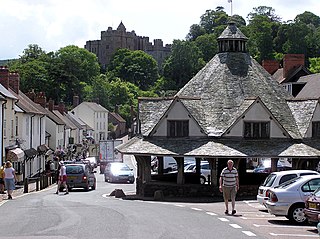
Dunster is a village, civil parish and former manor within the English county of Somerset, today just within the north-eastern boundary of the Exmoor National Park. It lies on the Bristol Channel coast 2.5 miles (4 km) south-southeast of Minehead and 20 miles (32 km) northwest of Taunton. The United Kingdom Census of 2011 recorded a parish population of 817.

Woodspring Priory is a former Augustinian priory. It is near the scenic limestone promontory of Sand Point and Middle Hope, owned by the National Trust, beside the Severn Estuary about 3 miles (5 km) north-east of Weston-super-Mare, within the English unitary authority of North Somerset. Many of the buildings are Grade I listed, and the whole site is scheduled as an ancient monument.

Bletchingley is a village in Surrey, England. It is on the A25 road to the east of Redhill and to the west of Godstone, has a conservation area with medieval buildings and is mostly on a wide escarpment of the Greensand Ridge, which is followed by the Greensand Way.
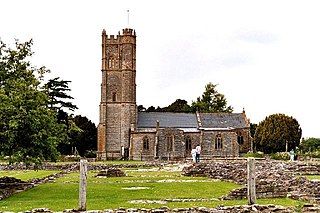
Muchelney Abbey is an English Heritage property in the village of Muchelney in the Somerset Levels, England. The site consists of ruined walls showing the layout of the abbey buildings constructed from the 7th to 16th centuries, and the remaining intact Abbot's House. It is next to the parish church in which some of the fabric of the abbey has been reused.
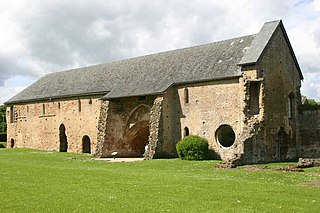
Cleeve Abbey is a medieval monastery located near the village of Washford, in Somerset, England. It is a Grade I listed building and has been scheduled as an ancient monument.
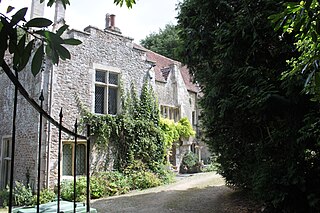
The Abbey, Beckington in Beckington, Somerset, England is a historic building that was founded as a monastic grange and also used as a college for priests; the building was begun in 1502, but after the Dissolution of the Monasteries it became a private house. It was altered in the early 17th century with a new front and a sumptuous barrel vaulted plaster ceiling, and also altered in the 19th century. The house was used as a school, restaurant and dance hall in 19th and 20th centuries but has now been restored as three houses: the most important plaster ceiling is in the house now known as "The Abbey".
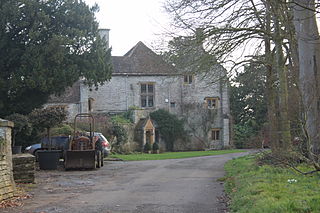
The Abbey is a Grade I listed building in Somerset, England. Built on the site of a 12th-century chapel, which might be incorporated in fragments, the main building dates to the 16th century.

Ditcheat is a village and civil parish 4.5 miles (7 km) south of Shepton Mallet, and 2.5 miles (4 km) north-west of Castle Cary, in the Mendip district of Somerset, England. Besides the village, the parish has four hamlets: Wraxall, Lower Wraxall, Alhampton and Sutton.

Norton-sub-Hamdon is a village and civil parish in the South Somerset district of the English county of Somerset, situated five miles west of Yeovil. The village has a population of 743.
Bossall is a hamlet in the Ryedale district of North Yorkshire, England with fewer than 100 residents. The Church of St Botolph was built in the 12th century with later alterations and is a Grade I listed building. The term Bosall was drawn from the name of 7th century bishop Bosa of York who was said to have built a church here.
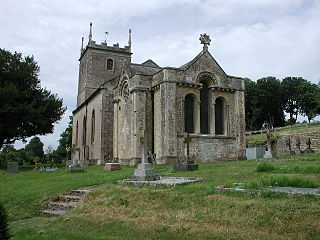
Marston Bigot is a small village in the civil parish of Trudoxhill, near Nunney and 3 miles (5 km) south of Frome in Somerset, England.

Blackford is a village and former civil parish in the county of Somerset, England, beside the A303 road, 4 miles (6.4 km) south west of Wincanton in the South Somerset district. There are two other places called Blackford in Somerset: one is a village near Wedmore, the other a tiny hamlet in Selworthy parish between Porlock and Minehead.

Stoke sub Hamdon Priory is a complex of buildings and ruins which initially formed a 14th-century college for the chantry chapel of St Nicholas, and later was the site of a farm in Stoke-sub-Hamdon, Somerset, England. The only building remaining from the college is a great hall and attached dwelling, dating from the late 15th century. The hall is designated by English Heritage as a Grade I listed building, while the outbuildings and gateway are Grade II listed. The whole site has been scheduled as an ancient monument. A number of the farm buildings are in poor condition, and have been added to the Heritage at Risk Register.
Saint Mary's Abbey in Colwich, Staffordshire was a monastery of Roman Catholic nuns of the English Benedictine Congregation, founded in 1623 at Cambrai, Flanders, in the Spanish Netherlands, and closed down in 2020. During the French Revolution, the community was expelled from France and settled at The Mount, Colwich, in 1836, where it remained for the next 84 years.

The Yarn Market in Dunster, Somerset, England was built in the early 17th century. It has been designated as a Grade I listed building and scheduled monument. Dunster was an important market place in the Middle Ages particularly following the construction of Dunster Castle and the establishment of the Priory Church of St George.
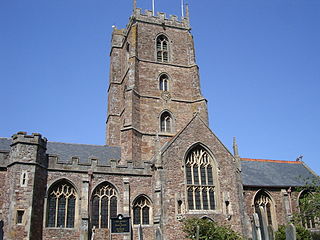
Dunster Priory was established as a Benedictine monastery around 1100 in Dunster, Somerset, England.
Wolston Priory was a Benedictine priory near Wolston in Warwickshire, England. The earthwork remains of the priory are a Scheduled Ancient Monument. A present grade II* listed house is based on the remains of the rectory.

The Dovecot At Blackford Farm in Selworthy on Exmoor within the English county of Somerset was probably built in the 11th century. It is a Grade II* listed building, and scheduled monument.
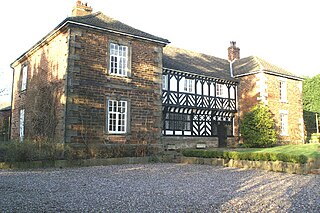
Mawdesley Hall is a country manor in Hall Lane, Mawdesley, Chorley, Lancashire, England. It consists of a central hall with two cross-wings. The central hall was built in the 17th century, its lower storey being timber-framed and its upper floor plastered and painted to resemble timber-framing. The cross-wings were added in the late 18th or early 19th century. The west wing is in sandstone, and the east wing is in brick with stone dressings. The hall is recorded in the National Heritage List for England as a designated Grade I listed building.
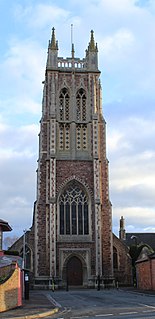
The Church of St George is a Roman Catholic church in Taunton, Somerset, which dates from the mid-19th century. It was the second Catholic church to be built in Taunton after the Reformation, replacing the much smaller St George's Chapel. The main church building is designated by Historic England as a Grade II* listed building, while the rectory is Grade II listed.


















